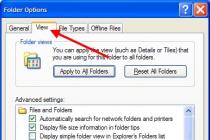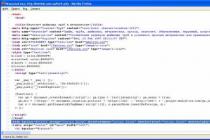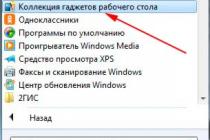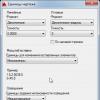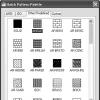In the modern world, in the information age, when technological progress is becoming increasingly important for society, digital technologies can no longer be dispensed with in any area of society. Trade was no exception, in particular Internet showcase.
Today, an increasing number of businessmen, manufacturers and sellers of various goods pay considerable attention to the promotion and advertising of their products and services through the global Internet. The positive experience of creating their own electronic representations of a huge number of companies testifies to the obvious benefits of the work of various commercial structures on the Internet.
Most companies that are successful and make huge profits outside the network seek to expand their sphere of influence and also attract the attention of a huge audience of Internet users to their product or service. Usually, special corporate websites are created for these purposes - representative offices of companies in the network, as well as online stores and online showcases.
Corporate websites are designed to tell potential clients and investors of the company as much information as possible about it: by whom and when the company was founded, what it does, what certificates it has, with whom it works, what services it offers and on the basis of what documents it concludes a cooperation agreement.
Online stores are used for retail (rarely wholesale) sale of various goods and contain pages with color photographs, a description for each product, a special “basket” option for buying goods and placing an order, plus a feedback form for clarifying points that are incomprehensible to the buyer work with the site, questions on goods, terms of sale and delivery.
Internet storefronts in general, they are similar in their functions to online stores and corporate websites representing companies on the Internet, but they do not contain online sales functions.
Online storefronts have two functions at once: firstly, they serve to advertise goods and services, i.e. they perform a commercial function, and secondly, they work as a mini-representation of the company on the Internet, the purpose of which is to provide customers with information about the company and its activities, that is, they perform an image function.
The performance of these functions determines the special structure of building the Internet storefront site. The site of such an electronic storefront provides such sections as: “about the company”, “news”, “forum”, “gallery”, “reviews”, “contacts” - these are the sections that are usually present on most corporate sites, but at the same time the Internet showcase also has sections specific to a store, for example: “products”, “catalog”, “place an order”, “basket”, etc.
The presence of certain sections on each specific site of the Internet showcase depends on the wishes of the customer for whom such a site is being produced, as well as on the characteristics of his company, promoted products, preferred methods of advertising and implementation, etc.
An online storefront can have any design, depending on the wishes of its owners. The main thing that should certainly be present is a well-designed, convenient for long-term viewing (decorated in colors that are pleasant and not tiring for the eyes) product catalog and an attractive appearance of all product cards.
A prerequisite for development Internet showcases- this is a mandatory design of the site in the general corporate style of each specific company for which such a site is being created. Failure to comply with this requirement adversely affects the implementation of the image function of the online storefront.
What is an online showcase? updated: December 3, 2018 by: All for IP
Internet showcases (web showcases)
The next option for organizing online retail is a web showcase.
On the pages of the Internet showcase there is information about the company, catalogs of products (services), price lists for them and an application form.
In the online showcase, you can publish company news, additional information about manufacturers, advice, analytical reviews, etc. Such a site, compared to traditional sources, provides more complete information about goods and services.
Among the online showcases, the following types can be distinguished:
static online storefront based on regular HTML files;
a dynamic online storefront displaying information from a certain database.
Along with participation in the electronic trading row, this is the least expensive solution, however, the online storefront, unlike the trading row, does not provide a full sales cycle, including interactive procedures for issuing invoices, accepting payments, tracking order fulfillment, etc.
The principle of operation of the Internet showcase is based on the collection of preliminary applications with their subsequent implementation. This principle works, for example, websites that specialize in the sale of goods of limited demand (such as, for example, art). The main problem for the seller is the need to guarantee the potential customer the execution of the order on predetermined conditions. The buyer runs the risk of receiving the selected product or service late (or not receiving it at all).
A distinctive feature of this business model is the implementation of the purchase and sale process in several stages. First, the seller collects applications, then finds out from the supplier the terms and conditions for fulfilling the order, after which he informs potential customers about this (usually by e-mail) and, finally, if they agree, ensures the delivery of the goods.
From the point of view of sellers, an online storefront and an online store differ quite significantly. An online storefront is inexpensive for trading companies, but it has significant drawbacks:
Disadvantages of online storefronts (1):
1) does not allow automating trading from a real warehouse;
2) does not allow reducing the staff of selling companies and their operating costs.
Disadvantages of online storefronts (2):
3) there is no flexibility in managing trade processes and organizing marketing campaigns.
All customer requests in the online storefront do not go to the automated order processing system, as in an electronic store, but to sales managers. Further, the business processes of the online storefront completely repeat the business processes of a traditional retail enterprise. In this case, there is no possibility of a real reduction in the level of transaction costs, the profitability of a web showcase differs little from the profitability of conventional trading methods. The main feature of this form of online commerce is that the processes of interaction between the web showcase and the internal business process of the company are carried out manually by managers (in the figure of the slide, this is shown by the corresponding arrows).
Online storefront transaction processing processes
Online store transaction processing processes
Thus, an online storefront is only a tool to attract a buyer, an interface for interacting with him and conducting marketing activities.
Consider now the concept and functions of an online store
Trade automation becomes profitable only with the growth of its scale. As long as a few employees can manage the manual processing of customer orders, especially if the number of customers is small, it is easier for merchants to organize online trading based on an online storefront. But for firms that conduct hundreds of transactions a day, this is unacceptable.
The most complex, albeit difficult to implement, e-commerce system is an online store that covers all the main business processes of a trading enterprise: choosing goods, placing orders, conducting mutual settlements, tracking order fulfillment, and in the case of selling information goods or providing information services -- delivery through networks of electronic communications.
The advantages of an online store compared to an online storefront are that the buyer can be offered personal service, a flexible system of discounts, as well as immediately issue an invoice, taking into account the cost of delivery, type of payment and insurance, and tax deductions. In addition, the buyer can receive information about the progress of his order. The use of this model in e-commerce allows you to significantly reduce inventory in warehouses and thus obtain significant cost savings compared to offline shopping malls. Since orders in the online store are processed automatically, the manager is no longer a necessary link in the customer service, his task is the overall control of the system.
As part of trading in online stores, as a rule, the principle of personalization is used, based on profiling technologies - the systematic collection and analysis of statistical information about customers.
According to this principle, the virtual merchant ensures that consumer preferences are taken into account. The client is offered a package of services and a set of goods focused on him, cumulative discounts, etc.
An online store is beneficial for a trading company that needs full control and management of all online trading processes and various marketing promotions (trade both to order and from a warehouse, advertising campaigns, organization of sales, etc.). The creation of an online store requires large one-time costs compared to a web storefront, but with a significant turnover, the use of online stores is much more profitable.
The online store includes the following main components (1):
Internet showcase - front office, located on a web server and equipped with a virtual consumer basket;
Payment system.
The online store includes the following main components (2):
System of accounting and control of execution of orders;
A back office whose information systems are integrated with front office systems.
The online store is designed to perform the following tasks (1):
Providing online assistance to the buyer;
Registration of buyers.
The online store is designed to perform the following tasks (2):
Providing an interface to the database of goods sold (in the form of a catalog, price list);
Work with an electronic basket ("trolley") of the buyer.
The online store is designed to perform the following tasks (3):
Placing orders with the choice of payment method, delivery, insurance and invoicing;
Reservation of goods in the warehouse.
Carrying out settlements (when choosing electronic payment methods) or controlling payment (when using traditional forms of payment);
Formation of applications for the delivery of goods to customers and the issuance of accompanying documents;
Providing the buyer with the means of tracking the execution of orders;
Goods delivery;
Collection and analysis of various marketing information;
Ensuring the security of buyers' personal information;
Automatic exchange of information with the back office of the company.
An online storefront is located on an Internet server and represents a website with active content. Since an online store must have a constant connection with the company's information system, it is located either on a corporate server in the company's local network, or on a remote server with a permanent communication channel. The need for full automation of the company's business processes determines the high requirements for the back office process management system. This system should provide automatic execution of all actions related to sales, warehouse operations, have internal mechanisms for controlling emergency situations, etc.
In general, the minimum hardware and software components required for the operation of an online store include:
The software and hardware components of the online store include (1):
Web server (distributes incoming requests from the Internet, differentiates access to information);
The software and hardware components of the online store include (2):
Application server (controls the operation of the trading system, in particular, the business logic of the online store).
The software and hardware components of the online store include (3):
DBMS server (provides storage and processing of data about goods, customers, accounts, etc.).
Payment systems are connected to this complex, and in some cases, delivery systems. To integrate with the company's business processes, an electronic data transfer gateway is organized between the online store and the company's internal automation system (document management system, ERP system, etc.).
The business model used significantly distinguishes from each other the options for building online stores:
Business models for building online stores (1):
online store (there is no traditional trading network).
Business models for building online stores (2):
combination of offline business with online business (when an online store is created on the basis of an existing real trading structure).
Stores of the second type have an undoubted advantage. In this case, symbiosis adds new opportunities to both types of business:
The online store takes advantage of shipping from an existing network of retail stores, it can offer the option of receiving goods at the selected store, unlike a purely online store, it has no problems returning goods;
Offline buyers can preview the product range and characteristics on the site, and then come to the nearest real store.
According to the availability of inventory, online stores can be divided into:
Working under contracts with suppliers (lack of any significant own inventory).
And also on-
Having their own warehousing (presence of commodity stocks).
The model of work under contracts with suppliers is based on the electronic mediation of a virtual trading enterprise between manufacturers or distributors of goods and retail customers.
More attractive than those of offline competitors, the prices are explained by the absence of costs for the acquisition (rent), maintenance and equipment of retail premises and warehouses and the low level of personnel costs.
This business model was immediately popular, but just as quickly it became clear that, while easily replicable, it did not provide a strategic competitive advantage. In other words, when many online stores enter the e-commerce market with previously unknown (or little-known) names and standard assortment, an individual seller cannot be sure that any significant number of buyers will choose his server to purchase goods.
Another type of online stores are those who have their own warehouse and inventory.
This may be an organization (Internet division) of an offline trade and service or manufacturing company. The scheme of interaction between the seller and the buyer in this case is almost the same as the scheme of the first model. The only difference is that in this case the store operates with goods from its own warehouse, and not from the supplier's warehouse and, therefore, is less dependent on external factors. This model is not as easily copied by competitors as the previous one, because it requires capital expenditures for the creation of a warehouse system and inventory.
The development of electronic commerce does not necessarily lead to a total increase in the number of customers and the turnover of the trading enterprise as a whole. Often there is a so-called "cannibalization" of sales markets, i.e. an online store begins to compete with the offline divisions of the company and increase turnover by poaching their customers.
The first interactive element of the interface that the user encounters is the product catalog, which reflects the product range of the online store.
The catalog is usually represented as a hierarchical tree structure, the basic elements of which are typical product groups and specific products (complete analogy with the file structure representation in OS Windows Explorer). When you click on a group, it expands to reveal the next level of that group. At the last level of each group, specific products of a certain type are presented. If desired, the buyer can see the image of the product and its detailed characteristics.
The completeness of the information placed in the catalog, the convenient presentation structure and the ability to quickly search largely determine the success of an online store. It is in the catalog that all information about the product available to a potential client is located, which should to some extent compensate for the absence of real samples and a sales assistant.
A significant role in the catalog can be played by 3D technologies, which make it possible to examine the sample of interest from all sides, look inside, etc.
However, the use of 3D technologies imposes increased requirements on the capabilities of the client's computer.
To ensure a quick search for the necessary information, an automated search system is used that works according to the parameters specified by the client: the name of the product, the required quality characteristics, the maximum price, etc.
In varying degrees, the structure of the product catalog affects the structure of the site. Placing a product according to an industry-accepted product classification does not guarantee a convenient search for customers. For example, when creating a product catalog for a perfume shop, it is not enough to use manufacturers' branded classifiers: the names of some sections will not tell the consumer anything (for example, aldehyde). Therefore, when developing a catalog, it is necessary to take into account the buyer's ideas about the classification of goods in this group.
The process of making a purchase in the online store consists of 2 stages:
Product selection (search, obtaining detailed information about the product, placing it in the basket);
Placing an order (selecting the form of payment and delivery).
If the purchase process was interrupted, for example, the user needed to urgently go on business, the online store remembers the current state of his basket. At the next visit to the store, the previously selected products will be in the shopping cart of the buyer. Depending on the policy of the store administration, the time of storing data on the shopping carts of the store's customers can be long (up to several weeks).
There are several types of baskets. The standard basket can be divided into main and auxiliary.
The buyer places all the goods he likes in the auxiliary basket, and at the time of placing the order he decides what to transfer from the selected to the main basket and pay, and what will remain in the auxiliary basket until the next visit to the store.
In addition, there is the concept of a standard basket, or a standard order. The need for such a basket arises in the case of regular purchases by some buyer of the same batches of goods.
The buyer forms the contents of the basket and declares it to be standard. In the future, he can change its contents. Each customer can create for himself an arbitrary number of such baskets. The most effective use of a standard basket with a wide range of purchased consignments of goods.
Another type of basket is a corporate basket for corporate customers. It is used to automate the supply of large geographically distributed enterprises.
The corporate basket is built on the basis of the baskets of individual structural units (departments, offices, branches, etc.) of one enterprise, takes into account spending limits on the supply of various structural units, restrictions on the financial resources of the enterprise, etc.
Having formed a basket, the client gives the command "Complete the order", while choosing the form of payment and delivery that is convenient for him.
An important component of the interaction between the buyer and the store is registration, in which the buyer provides the store with the data necessary for:
1) identification (name, password);
2) direct purchase (full name, address, phone number, e-mail address, etc.).
In the future, this information is used in all interactions between the buyer and the store - the buyer only needs to identify himself. During registration, the online store ensures the safety of the buyer's personal information by using secure channels for data transfer, such as the SSL protocol.
Registration is an optional condition for visiting the online store. At the same time, it provides a number of advantages. Firstly, registration allows the buyer to always see the status of his orders, save the contents of the basket for future visits. Secondly, there is no need for each purchase to specify the data required for its implementation (address for delivery of goods, legal details of the organization, etc.). Registration allows, by tracking the preferences of a particular buyer, to personalize the service: provide personalized information, set prices taking into account individual discounts, maintain order history, etc.
Data about the buyer and the contents of his basket are sent to the managers in the back office of the online store. The back office software includes an interconnected database of incoming orders with tracking of their implementation, a database of customers with their credit history, an automated warehouse accounting and accounting system, applications for top managers and the client part of the Internet banking system, etc.
Order processing starts from the moment the application is made and includes the following steps:
Checkout steps (1):
Reservation of goods in the warehouse;
Payment (in online mode, payments are made automatically, in offline mode, an invoice for payment is issued and then the fact of receipt of funds is monitored).
Checkout steps (2):
Preparation of documents for the delivery of goods.
The software of the online store automatically generates, signs with the electronic digital signature of the store and sends an invoice to the client, according to which he can pay and receive the goods in the store within a certain time. An electronic invoice in this form is the basis for payment. Online stores allow you to pay by postal order, plastic card, electronic money, regular bank transfer or cash (when using courier delivery or when receiving goods in an offline store). After the message about the payment, the trading system forms an order for the delivery service. The buyer can receive information about the progress of the order online.
Consider the advantages and disadvantages of the main methods of payment for goods in online stores.
Advantages and disadvantages of payment methods for goods in online stores (1):
1. Cash payment to the courier. Payment is made at the time of delivery of the goods by the courier.
The advantages of this method:
Guaranteed receipt of goods (buyer) and money (seller);
The ability to check the goods (and completeness) immediately and, if desired, return it, refusing to purchase;
Possibility to get advice from a courier.
This method is one of the simplest, most reliable and convenient.
The disadvantages of this method: significant costs for the courier service, especially when selling outside the city, and the inability to provide a high level of service and pre-sales services.
Advantages and disadvantages of payment methods for goods in online stores (2):
2. Payment and receipt of previously ordered goods in the store.
In terms of reliability, this payment method is no different from a simple purchase in an offline store. The buyer, having placed an order in the online store, indicates in which of the real stores of the company he wants to receive it and, after the expiration of the established period, purchases the goods in the designated store.
The benefits for the buyer are the same as in the first case, plus:
Looking at the store, the buyer can conclude that the seller is reliable;
The process of buying in a traditional store is familiar to everyone;
There are no psychological problems that are typical for courier delivery - buyers are wary of the appearance of strangers in their home;
It is relatively easy to guarantee a high level of service and pre-sales services.
The disadvantage for the buyer is that he must go to the store to buy. The disadvantage for an online merchant is the need for a physical store. As a rule, only online stores organized on the basis of offline trading enterprises can afford this.
Advantages and disadvantages of payment methods for goods in online stores (3):
3. Cash on delivery. After placing the order, the goods are sent to the buyer by mail. Payment is made at the post office, directly upon receipt.
Advantages:
No geographic restrictions;
Relatively low shipping cost.
Disadvantages:
The impossibility of preliminary acquaintance with the goods (the contents of the mailing can be checked only after the purchase has been paid);
Unreliability of delivery (the goods may deteriorate during transportation);
Significant delivery time (longest of all possible options).
Advantages and disadvantages of payment methods for goods in online stores (4):
4. Payment by bank transfer. After placing an order, the buyer is issued an invoice, which can be paid through the cash desk of any bank (for individuals) or from a current account (for organizations). The method is convenient for organizations. For an individual, this method of purchase is not so convenient - you must first go to the bank to pay, and then wait for the goods to be received. This option is characterized by all the disadvantages of cash on delivery.
Advantages and disadvantages of payment methods for goods in online stores (5):
5. Payment with a plastic card. To make a payment, the buyer enters the details of the plastic card in a special screen form and receives a notice of debiting from the account, indicating the completion of the payment.
The advantage is the simplicity of the payment process. The disadvantage is the low level of security of payment transactions.
Advantages and disadvantages of payment methods for goods in online stores (6):
6. Payment using electronic money, electronic checks.
In order to use this payment method, you need to install a digital wallet (electronic wallet) on your computer and connect to the electronic money system.
Advantages of this method:
High degree of security;
Simplicity and convenience of the payment process.
Disadvantages of the method:
The need to create a wallet with electronic money;
There may be costs associated with paying for the services of payment systems.
This method is ideal for those who frequently shop online as it is safe and secure.
After the order and mutual settlements, data on purchasing activity enters the system. In the process of working with the buyer, marketing information is constantly collected and analyzed. The owner of a virtual store, having complete information about website visitors, can build a marketing policy in accordance with it.
In addition to the basic components (product catalog, order archive, electronic shopping cart) that ensure the implementation of business processes, the online store contains a number of additional information sections.
Any online store needs sections:
General information about the store;
On the specifics of the product range;
Quick search form for the desired product (due to the high popularity, the search form is usually located on the main page);
Assistance in navigation and purchase;
Target market news;
Answers to frequently asked questions (FAQ and "context clues").
It is important to pay attention to the "Help" section, its absence is the reason for the rejection of many purchases. According to research by Andersen Consulting, about 25% of buyers do not make purchases due to lack of information about the product (service). 62% of buyers answered the question: "What actions on the part of online stores could push them to make a purchase?" that it could be reviews, recommendations on goods and services. Another 58% (multiple answers were allowed) said they needed advice on color, size, quantity, etc.
It is known that making a visited store based on an information portal is much easier than organizing a popular news section in an online store. Therefore, novice online stores are trying to find an information partner. A store has goods and money, a news site has an audience and information. Combining these resources gives a good economic result.
The structure of the site is not limited to the sections listed above. According to research by JUPITER COMMUNICATIONS, 24% of online stores use the "Hits" section (aka "Top Sellers", "Best Products", etc.). This allows you to increase sales. It is no secret how much public opinion influences a person, especially when he is in doubt.
The main feature of the online showcase is the fact that here users can view the product and its characteristics.
Creating an online storefront helps to promote your products and services among consumers faster and more efficiently. It is very important, when developing your Internet project, not to confuse two completely different concepts: an online store and an online storefront.
Creating an online storefront is done with the aim of acquainting consumers with a huge selection of the company's products, but not selling it through the network. Most often, an online storefront is a catalog that contains all the goods and products of a company. A potential buyer can view the provided goods and choose for himself what he needs.
Such web resources help to significantly promote your business, and also cost much less than the development of other Internet sites.
Internet showcase - the face of the company
Online storefronts differ from other web resources in that they only present a company's product or service, not selling it. As a rule, this is a corporate website where visitors can find information about the product they are interested in, its description, cost and specification. In addition, often such resources also provide visitors with the necessary information about what the company can offer to its customers and customers. Of course, creating a showcase on the Internet does not pose any particular difficulties, but when there are too many names of a wide variety of goods, the creation work requires the hands of real specialists.
Internet showcase features:
- An online storefront helps to find new buyers and consumers. If we talk about this feature, then these sites are indexed in such a way that allows them to automatically find buyers using a variety of search engines.
- A web resource in the form of a showcase allows you to increase the possible income of your company several times.

At the request of the customer, we can add a simple email order form to the product page! To make it easier to imagine how an online storefront works, you can take as an example thick catalogs with products that may be of interest to potential buyers.
Creating an online storefront involves the use of a variety of approaches:
- Creation of a catalog, which will take into account the necessary features to facilitate work with search engines;
- Such a site needs constant work on its promotion by specialists so that potential buyers can easily and effortlessly find the product they need;
- Internet showcase is more of a business site than a simple online presence.

What do you get by contacting us?
- A custom designed design that will perfectly suit your company's goals.
- We use a CMS that does not carry a heavy load on the server.
- We will add some variety to your storefront by creating reviews, ratings and other features
- We offer our clients an administrative panel for filling the site.
- We also offer support for modern html standards and the possibility of search engine optimization.
Having decided to contact our company, you can be sure that your virtual storefront will become a real breakthrough for your business.
Spectra of application of web showcases
A web storefront is an inexpensive form of retail organization. It allows you to ensure the process of interaction with the consumer, receiving and processing applications. The implementation of the further delivery of goods is carried out in traditional ways.
Forms of retail organization based on the use of the Internet can be varied. The most effective are, of course, online stores, but, in some cases, it is advisable to use web storefronts.
Many enterprises that are engaged in the production and sale of original products cannot standardize their products and services. For example, it can be works of art, original items for interior decoration, designs that require compliance with individual sizes and shapes, handicrafts, and others. In this case, they can create online storefronts that help inform consumers about the company's capabilities. In addition, web showcases can be used by companies with a very large and constantly changing product range that can only be presented by target groups. Or, such a showcase can perform a representative function, reflecting the main activities of the company.
In general, web showcases can also be used by enterprises that do not have sufficient capital to organize a full-fledged online store, or other types of electronic systems that provide automatic sales of products.
On the pages of a web showcase, you can place information about the company's activities, its advantages and features, a product catalog and a price list for it, and they can also be filled with useful tips, articles that allow consumers to more fully perceive the purpose of the goods. In addition, they can contain analytical reviews, opinions of experts and specialists, pages of reviews and suggestions, and other useful aspects. A prerequisite for working with web storefronts is the availability of a special application form, by filling out which the consumer can express his desire to purchase goods or services.
Of course, the online storefront does not allow for a full sales cycle, and cannot provide interactive procedures such as invoicing, order tracking, payment acceptance and other processes. However, the web showcase allows you to collect applications and subsequently fulfill them. The organization of this form of trade is incomparably cheaper than other types. However, consumers may be somewhat distrustful of the possibility of high-quality and timely execution of the order, so the seller must think over and provide guarantees.
This form of business model involves the execution of an order in several stages. First, the application is analyzed, then coordination with suppliers is made, then the conditions are agreed with the buyer, and only after that the order is executed.
Compared to an online store, a web storefront has a number of disadvantages. It does not provide an opportunity to automate the processes of trading from a warehouse, does not allow to reduce staff and reduce operating costs, does not have flexibility in management, and does not contribute to the organization and conduct of effective marketing campaigns and other promotional activities. All requests from consumers go to the company's managers, and not to the automatic order processing system.
In fact, a web showcase is a common tool that allows you to attract customers, and it is also a convenient interface for interacting with them. In general, the processes differ little from traditional retail methods. However, the web storefront provides the main goal - the global presence of the seller in the market, thanks to the Internet.
This method of organizing trade can also be used by individual entrepreneurs who do not have sufficient capital to fill the warehouse with goods. They can act as intermediaries between buyers and suppliers with whom partnerships have been concluded. They can take, process orders, provide consumers with extended information about the quality and benefits of the product, and take on the function of coordinating the supply.
Another type of retail organization on the Internet is an Internet storefront, or web storefront.A web showcase is a site that is designed to demonstrate the goods and services of the showcase owner using the Internet.There is a more detailed definition of the concept in question:
As a rule, the pages of the web showcase contain information about the company, catalogs of goods and services, price lists and a form for filling out an application. Here you can publish company news, additional information about manufacturers, analytical reviews, etc. Information about all orders is sent to the mailbox of the seller, whose employees execute them in the prescribed manner. If we compare a web showcase with traditional sources, then the latter cannot provide such complete information about goods and services, unlike the former.
Among the web showcases are varieties:
Along with participation in an electronic trading row, this solution is the least expensive, however, a web storefront, unlike a trading row, cannot provide a full sales cycle, including interactive procedures for issuing invoices, accepting payments, tracking order fulfillment, etc.
The principle of operation of the web showcase is based on the collection of preliminary applications with their subsequent implementation. For example, websites that specialize in the sale of goods of limited demand (art objects) work according to this principle. The main problem of the seller is the need to provide a guarantee to a potential client about the fulfillment of an order on predetermined conditions. Buyer problem: the risk of receiving the selected product or service late (or the risk of not receiving the product/service at all).
A distinctive feature of this version of the business model is the implementation of the purchase and sale process in several stages. The first stage is the collection of applications, which is what the seller does, then he asks the supplier for the terms and conditions for the execution of the order, after which he notifies potential customers about this (usually by e-mail) and the last stage is the delivery of the goods, provided that the consumer has confirmed his consent .
Although a web storefront is a relatively inexpensive retail tool, it has significant limitations:
- does not allow automating trading from a real warehouse;
- does not allow the reduction of the staff of sales firms and their operating costs;
- lack of flexibility in the management of trade processes and the organization of marketing campaigns.

